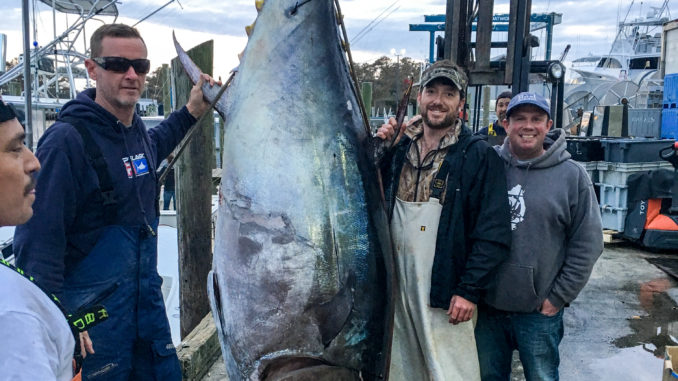
Both fish caught on same trip from 27-foot boat
After being towed nearly 15 miles by a bluefin tuna that pushed 600 pounds, Daniel LeGrande of Virginia Beach, Va., and his crew chose to return to their hot spot outside of Oregon Inlet rather than head in with their catch. They were rewarded shortly thereafter with a giant in the 900- to 1,000-pound range that bit a false albacore trolled behind his 27-foot center console.
A charter captain based out of Virginia’s Lynnhaven Inlet, LeGrande makes a living chasing striped bass and cobia in Virginia waters. But for the past 10 years, he’s made the 90-minute trek south to target bluefin tuna when they’re accessible outside Oregon Inlet. On Feb. 22, LeGrande and his crew, George Dillinger and Patrick Callahan, had one of their best days yet.
“We arrived on the scene right before daybreak,” said LeGrande (757-374-2307). “We were fishing right as the sun was coming up. The three boats in our area all got good marks right off the bat, and in about 20 minutes, all three of us were hooked up.”
LeGrande pulled a 4-rod spread of horse ballyhoo from 4 to 6 knots in 200 fathoms of water about 40 miles off Oregon Inlet near an area known as The Point. His rods featured a naked ballyhoo, a crystal Ilander, and two 8-ounce Jag Lures from Blue Water Candy. The first fish struck the Ilander on the long rigger about 150 yards behind the boat.
“We fought that fish for about an hour-and-a-half,” said LeGrande. “Once we got him harpooned, the hard part was getting him in the boat. At the time, that was one of the bigger ones we’d ever caught.”
On their way back to The Point, they noticed large schools of false albacore within a couple miles of the original hook up, and they caught one. Just for sport, they flossed a 14/0 circle hook through its eye sockets, tossed it overboard and trolled it about 100 feet behind the boat, just beyond the prop wash.
“It wasn’t there 10 minutes and something ate it,” said LeGrande. “We weren’t sure what it was. It was steady and slow, never really took an excessive amount of line. We were thinking maybe a big shark, so we put the drag to the full 45 pounds of pressure on him. After about an hour, the fish just gave up, had a heart attack and started coming up backwards on us.”
Not until the fish was harpooned, tail-roped, and gaffed could its size be truly appreciated — that’s when LeGrande knew there was a problem.
“We had to call in for back up,” said LeGrande. “A couple of buddies on the Albatross
came in and brought us two more guys and another block and tackle. We tried four or five different attempts, different angles, but we just couldn’t break the plane. So, we finally ended up having two guys on the bow of the other boat get tail ropes and they had to lift on the tail while we were pulling on the head. It probably took us an hour-and-a-half to two hours to get that fish in the boat. We had quite a bit of meat and that was with a 600 pounder already laying there. For a boat our size, there was not a lot of room.”
Back in port, the the smaller of the two measured 97 inches and cored out at 417 dressed. The largest measured 108 inches and cored out at 697 pounds — easily putting it more than 900 pounds live weight.




